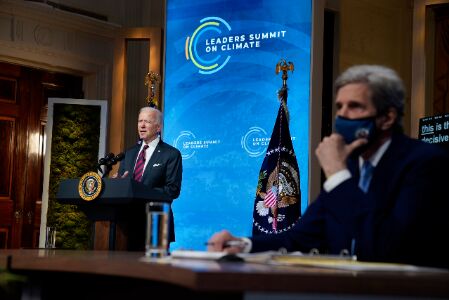A big commitment
Biden's ambitious pledge at the summit is a tall promise — fulfilment is still a daunting task; write Morgan Bazilian & David Victor

President Joe Biden announced an ambitious new national climate target at an online summit of world leaders on April 22, 2021. He pledged to cut US carbon emissions to half by the end of this decade and aims for net-zero emissions by 2050.
The new goal is a big deal because it formally brings together the many different ideas on infrastructure, the budget, federal regulatory policy and disparate actions in the states and industry for transforming the US economy into a highly competitive, yet very green giant. It also signals to the rest of the world that "America is back" and prepared to work on climate change.
Stopping global warming at 1.5 degrees Celsius — the aim of the Paris climate agreement — will require an immediate global effort that can transform energy systems and make emissions plummet at rates never observed before in history. Statements from the 40 world leaders at the virtual summit reflected both ambitious visions for that future and the reality that words don't always match actions on the ground.
In effect, the new targets are a nonbinding pledge to the rest of the world. Beyond the headline figures — including the new promise to cut emissions 50-52 per cent by 2030 compared to 2005 levels — Biden's pledge pays attention to the need to adapt to the climate changes already underway and build resilience.
These new goals show real momentum but will the new US pledge have an impact on emissions that's as huge as the pledge sounds?
Can the US meet its new goal?
Our chief concern is industrial reality — cutting emissions by half within a decade implies transforming the electricity system, transportation, industry and agriculture.
These systems don't turn on a dime. The goal setting is the easy part. It is largely a combination of technical feasibility with political palatability. The tough work is getting it done.
Pretty much everything will need to line up quickly — policies that are credible and durable, along with industrial responses. As often happens with technological change, most analysts are overestimating how quickly things can transform in the near term, and probably underestimating how profound change will have to be into the more distant future.
The Biden administration now has a goal for electricity to be carbon-free by 2035. Nearly every study that shows a 50 per cent drop in US emissions is feasible is based on the observation that the power sector will cut emissions at a fast clip.
For all the progress in electricity, pushing that sector to be net-zero soon will create tensions and tradeoffs. For example, distress from the sharp decline of the coal industry is already evident in communities across Appalachia.
Politics and a climate summit
The US is the world's second-largest greenhouse gas emitter, and one of the highest in emissions per person. But its emissions are less than 15 per cent of the global total, so it is essential that whatever happens in the US be linked to a global effort. That's why credibility matters so much.
But the Biden administration has to move carefully. Tempting as it is to tighten the screws on emissions, efforts that are too aggressive will easily become fodder for the political opponents and industries that have undermined climate efforts in the past.
The shift in climate politics is important to watch. Biden has a barely functional majority on Capitol Hill, and the real politics of climate change aren't simply about the technical scenarios of cutting emissions with cleaner technologies. They are also about how society transitions.
The US still needs to prove itself
The White House had high expectations for the summit, including expecting several countries to announce new commitments. The UK pledged just ahead of the summit to cut emissions 78 per cent by 2035, and the EU announced a provisional deal on 55 per cent emissions cut by 2030.
The virtual summit also drew Russian President Vladimir Putin, Chinese leader Xi Jinping and Brazilian President Jair Bolsonaro — three frequent US adversaries and major contributors to climate change through fossil fuels or deforestation. Putin promised big action and to "significantly cut the accumulated volume of net emissions" in Russia, and Bolsonaro promised to protect the Amazon rainforest, but not end illegal deforestation for another 10 years. Both highlight how easy it is to promise great things at climate summits even when one's track record points in the opposite direction.
One indicator of the actual success of the summit may be China. US-China diplomacy in the run-up to the UN Paris climate meeting was widely seen as essential to its success five years ago. This year, when presidential climate envoy John Kerry met with his Chinese counterpart a few days ahead of the April 22 summit, the joint statement concluded with a somewhat generic agreement to cooperate on climate change and ensure the world meets the Paris goals.
After four years of the Trump administration's antagonism, undermining of the US credibility overseas, and with so much domestic work on climate still needed, a US-hosted summit may have been premature. The intense diplomatic efforts to pressure other countries to make announcements at the event seemed out of touch with the US need to get its house in order first.
The White House pledge is bold, but it remains long on adjectives and short on credible verbs. Whether it will have an impact on domestic actions or it will help convince the world that the US is a trusted and durable partner on climate change remains to be seen. DTE
Views expressed are personal



